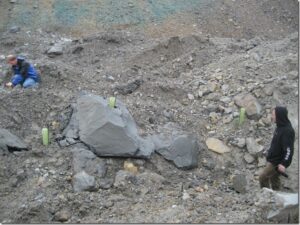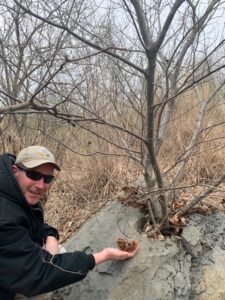Looking at the bare rock mine surface from a reclamation research project in Eastern Kentucky, most of us would have little faith that much would grow on such a soiless surface.


However in 2007, Michael French was a big part of a U of KY Research Team, who planted several tree species, including full and hybrid American Chestnuts, in a variety of test plots seeking best practices for mine reclamation. Michael used this research for his Master’s Thesis at UK.
In this plot of mixed mine rock, several Allegheny Chinquapin nuts were planted with tree shelters as protection against wildlife predation. Note the planting, by Team Member Terry Stamper, in the drill bore hole that blasted chunks of rock when the mining of coal was active. A variety of hardwood tree species, including American Chestnuts, were planted in the other plots.
In the two following photos on March 8, 2023, Michael was delighted to find at least 10 surviving Chinquapins (Castanea pumila), including the one planted in the bore hole. Even better, was to find several of the trees producing fertile burrs and nuts. Multiple other tree and weed species are also growing, thanks to birds.
From this large project, Michael went on to a career in leading crews in plantings of multiple tree species, including American chestnuts, with KY TACF Partner, GREEN FOREST WORKS, based in Lexington, KY. Their story is much too large for a single Post. Check out their website:
https://www.greenforestswork.org/

